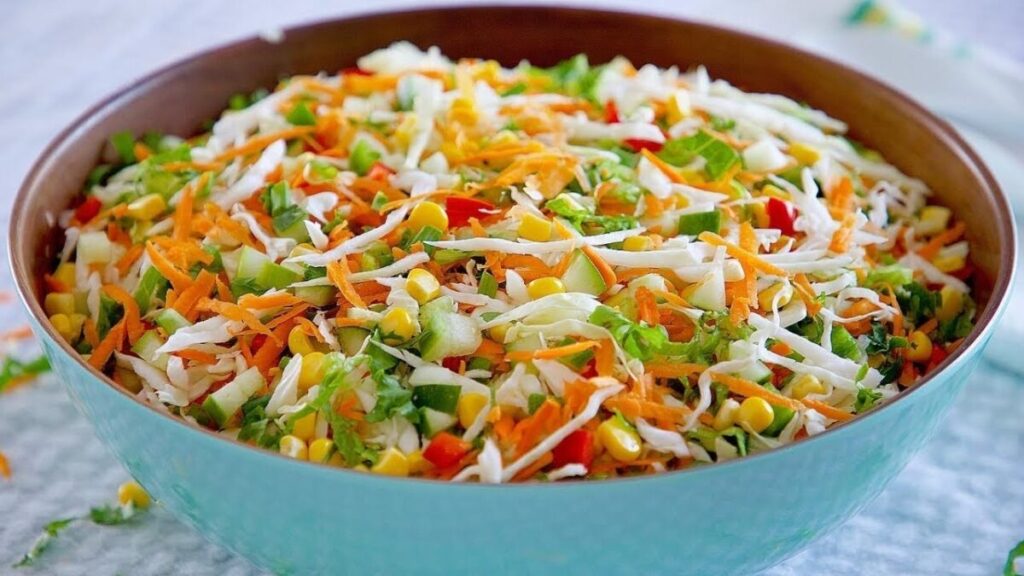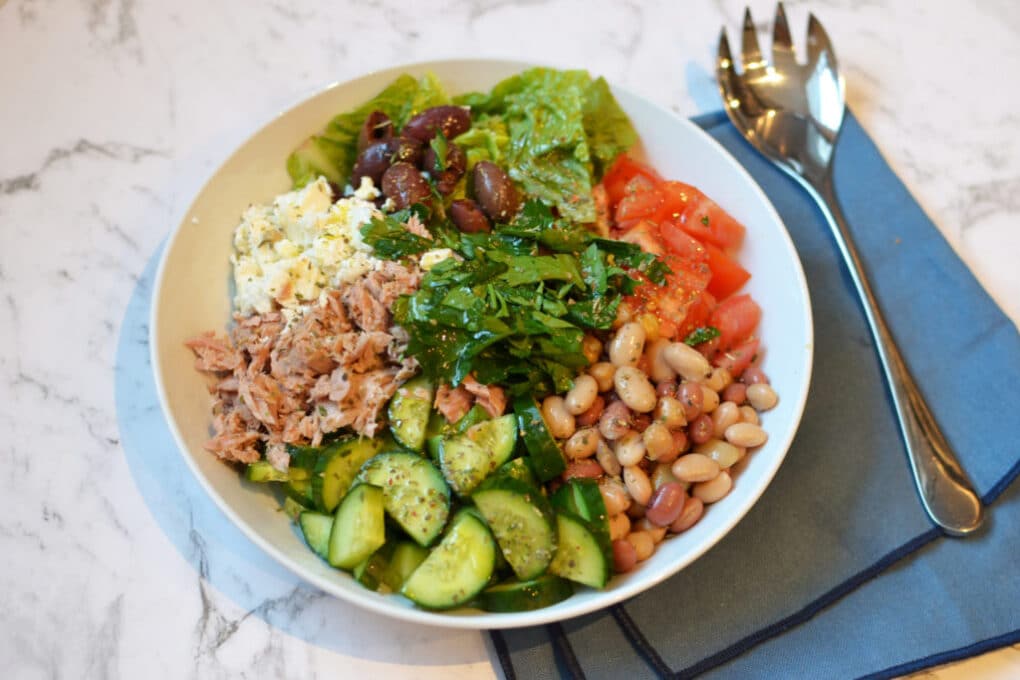Learning how to make salad is a great way to make a nutritious and satisfying meal. Salads are a healthy and delicious meal option that can be customized to suit any taste.
Salads are a versatile and nutritious meal option that can be enjoyed year-round. They are a great way to incorporate a variety of vegetables, fruits, and proteins into your diet while keeping your calorie intake in check.
Salads can be customized to fit your taste preferences and dietary needs, making them a perfect option for vegetarians, vegans, and people with food allergies.
In this article, we will explore the different components of a salad and provide tips on how to create a delicious and healthy meal. Salads are an excellent choice whether you’re looking for a quick and easy lunch or a side dish for dinner.
READ ALSO:

Ingredients for making Salad
Greens – such as lettuce, spinach, kale, arugula, or mixed greens
Vegetables – such as tomatoes, cucumbers, bell peppers, carrots, onions, or radishes
Fruits – such as apples, strawberries, grapes, or oranges
Nuts and Seeds – such as almonds, walnuts, pecans, or sunflower seeds
Protein – such as chicken, salmon, tofu, eggs, or beans
Cheese – such as feta, goat cheese, or shredded cheddar
Dressing – such as vinaigrette, ranch, or honey mustard
Choosing the Greens for your Salad Base
Start with leafy greens
They are a traditional salad base and offer a range of nutrients. Try to find greens like mixed lettuce, spinach, arugula, or kale. Choose the greens according to your preferred flavour and texture.
Think about Color
Mixing up your greens can bring diversity to your diet and make your salad look more attractive. Think about utilizing colourful greens, such as purple cabbage, red-leaf lettuce, and green kale.
READ: How to Boil Corn on the Cob
Check for Freshness
The taste and nutritional value of your salad depend on how recently it was prepared. Look for clean, spotless greens that don’t have any brown or other imperfections. Greens that are slimy or wilted should be avoided.
Consider the Season
For the freshest and most flavorful alternatives, pick greens that are in season. For example, in the summer months, you can go for lighter, more delicate greens like butter lettuce, while in the fall and winter, you might prefer heartier greens like kale or collard greens.
Experiment with different bases
Don’t be afraid to experiment with other salad bases, such as grains like quinoa or couscous, pasta, or beans. They are a fantastic source of protein and can add diversity to your salads.
Adding Vegetables
Select a Range of Colors
Using a range of coloured veggies in your salad guarantees that you are obtaining a variety of nutrients while also improving its aesthetic appeal. Think of utilizing produce like radishes, tomatoes, cucumbers, bell peppers, and carrots.
SEE: The Best Way To Prepare Jollof Rice
Utilize Cooked or Raw Vegetables
Depending on your desire, you can use cooked or raw vegetables in a salad. While cooked veggies can add taste and tenderness, raw vegetables offer a pleasant crunch and typically retain more of their nutritional value.
Blend Various vegetable texture
Your salad will taste better if you combine different textures in it. Use both softer foods like tomatoes or avocado and crisp vegetables like carrots or peppers.
Remember the Herbs
Fresh herbs may give your salad a lot of flavour without adding unnecessary calories. Think about including herbs in your salad, such as basil, cilantro, or parsley.
CHECK THESE OUT:
Fruits and Nuts
Here are some tips for Boosting Flavor with Fruits and Nuts in your salad
Choose fruits that complement your salad
Fruits like strawberries, blueberries, apples, and pears can add a sweet and juicy flavour to your salad. Choose fruits that are in season for maximum flavour.
Add some crunch with nuts
Nuts like almonds, pecans, and walnuts can add a satisfying crunch to your salad. Toast them lightly in the oven or on the stovetop before adding them to your salad for extra flavour.
Mix in some dried fruit
Dried fruit like cranberries, raisins, or apricots can add a chewy texture and sweet flavour to your salad. Be sure to choose unsweetened options to avoid adding unnecessary sugar.
Try something exotic
Fruits like mango, papaya, or kiwi can add a tropical twist to your salad. Pair them with spicy greens like arugula or watercress for a flavorful and unexpected combination.
Proteins Options for Salad
Chicken
Chicken that has been grilled is a popular option for adding protein to salads. To enhance the flavor of the chicken, you can marinade it in advance or simply season it with salt, pepper, and herbs like rosemary or thyme.
SEE: How to cook fried rice one step at a time
Shrimp
Shrimp is a fantastic choice for a seafood twist. Shrimp can be boiled, sautéed, grilled, or added to salads.
Tofu
Tofu is a wonderful source of protein for vegetarian or vegan options. Tofu can be added to a salad and grilled, baked, or pan-fried for a filling supper.
Hard-Boiled Eggs
Adding hard-boiled eggs to your salad is a simple and fast approach to boosting the protein content. To add eggs to your salad, just boil, peel, and cut them.

Tips for trying different salad combinations
Change up your greens
Try varying your greens rather than consistently using the same lettuce. For a distinct flavour and texture, use spinach, arugula, kale, or even cabbage.
Mix up the textures of your ingredients
Consider including a range of textures in your salad. Add some crunch with croutons or chopped nuts, for instance, and some creaminess with cheese or avocado.
Have fun with colour
Your salad will appear more delicious and contain more nutrients if you include colourful veggies like cherry tomatoes, carrots, or bell peppers.
READ: How to cook Okro Soup – Nigerian Okro Soup Recipe
Mix salty and sweet
Mixing salty and sweet elements can result in a distinctive flavour profile. Consider including fruits in your salad, such as apples, grapes, or dried cranberries, and pairing them with foods like chicken, bacon, or goat cheese.
Try different dressing
Don’t be hesitant to experiment with different dressings to alter the flavour of your salad. Try different store-bought dressings, or try making your own.
Conclusion
In conclusion, making a salad is a simple and healthy way to create a delicious and nutritious meal. With the right combination of ingredients, you can create a salad that is packed with vitamins, minerals, and protein.
Whether you prefer a simple green salad or a more complex combination of flavours, there are endless possibilities for creating a delicious salad.
By experimenting with different ingredients, dressings, and toppings, you can create a unique and satisfying salad that is perfect for any occasion. So why not try making a salad today and see what delicious creations you can come up with?
FAQS on How To Make Salad
What ingredients to put in a salad?
Greens – such as lettuce, spinach, kale, arugula, or mixed greens
Vegetables – such as tomatoes, cucumbers, bell peppers, carrots, onions, or radishes
Fruits – such as apples, strawberries, grapes, or oranges
Nuts and Seeds – such as almonds, walnuts, pecans, or sunflower seeds
Protein – such as chicken, salmon, tofu, eggs, or beans
Cheese – such as feta, goat cheese, or shredded cheddar
Dressing – such as vinaigrette, ranch, or honey mustard
How do you prepare salad?
Put the eggs to boil. Slice.
If you are using frozen sweet corn, pour the corn into a microwave-safe dish with enough water to cover; and enough room left for the water to boil without spilling. Place in the microwave and heat for 5 mins. Bring out and pour in a colander to drain. Keep aside to cool.
If using canned sweetcorn, drain in a colander and keep aside.
Pour the baked beans in the colander to drain.
Slice the onions thinly. Soak in a bowl of cold water with some salt. Leave for 10 mins, then drain.
Wash all the vegetables. Grate the carrots. Slice the lettuce. Slice the tomatoes.
Cut and remove the seeds from the cucumber.
Add all of the ingredients to a bowl. Tear the dill and spread it over the top, then refrigerate.
Bring it out of the fridge when you are ready to use it. Serve and add the dressing to the served portion.
How do you make a 5-step salad?
Choose your salad base
A salad usually starts with a base of a mild-tasting leafy green. Salad base examples: Iceberg lettuce, romaine lettuce, spinach, kale, watercress, arugula, Belgian endives, and bibb lettuce.
Choose your Protein
Adding protein to a salad makes the salad more filling. It also helps to make the salad more satisfying. You can include proteins like Chicken breast, steak, turkey, tuna fish, fish (salmon), shrimp, boiled eggs, cheese, beans, and tofu.
Choose your Fruits
Fruits add healthful vitamins and nutrients to your salad. However, they also add beautiful colour, texture, and amazing flavours to your salads. The fruits include Apples, strawberries, blueberries, grapes, cherries, avocados, pineapples, bananas, and oranges.
Choose your Toppings
Adding toppings to your salad is totally optional. Choose toppings to your liking, or match them up with the flavour profile of your salad. The toppings can be dried cranberries, raisins, dried fruit, nuts/seeds, candied nuts, cheese, and olives.
Choose your Dressing
When it comes to dressing your salad, there are so many options to go with, so the choice is yours. Your salad dressing can either be the sweet style or savoury style, and you can make it both.
What are the 5 basic types of salads?
The five basic types of salad are green salads (tossed or composed), bound, vegetable, fruit, and combination.
The two types of green salad are tossed and composed (or mixed). Prepare all ingredients individually for either salad.
Prepare the bound salad from cooked primary ingredients such as meat, poultry, fish, egg, or starch such as potato, pasta, or rice.
Prepare a vegetable salad from cooked and/or raw vegetables.
Prepare a fruit salad from fruit using a slightly sweet or sweet/sour dressing to enhance the flavour.
A combination salad incorporates a combination of any of the four salad types.
